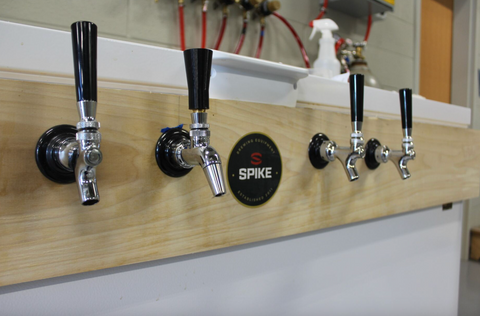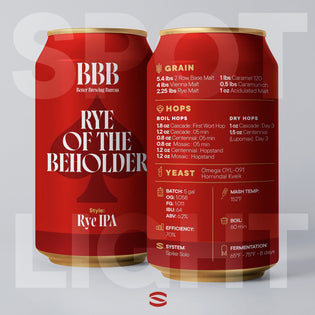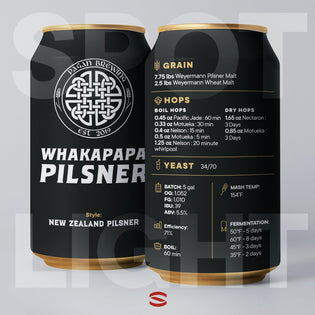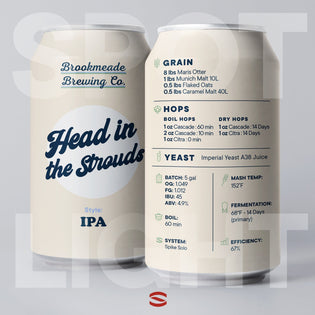
The Brewer(s): Fermentation Science Students
Hi, I’m Mike, and I’m the Program Coordinator for the first of its kind, two-year Associate in Applied Science Fermentation Science program at Madisonville Community College.
I’ve been a homebrewer since college and fell in love with the exciting and vibrant world of craft beer. There’s always something new - like bacon-flavored porters or dill pickle beer - but at the end of the day, it’s more than just beer. It’s all about the community, collaboration, and connections that the industry helps foster.
At Madisonville Community College, we encourage students to think outside the box as they explore, learn, and develop his/her brewing skills. We offer a hybrid program, meaning the content is all online which expands our reach to students across the state and beyond. So that means, you don't need to live in Kentucky to take our class!

But the students still need that hands-on experience, so we’ve partnered with breweries across the country that allow our students to do their lab work in their breweries – and what better way to learn and get their practicum hours than under the supervision of a professional brewer?

I knew we needed equipment that matched the standards of smaller commercial breweries. Spike's 1bbl Nano system with its electric brewhouse provided the perfect solution. Tight process control is absolutely critical if you’re going to make a good, consistent product, and with the brewhouse panel and temperature-controlled fermenters, the Spike Nano ensures consistent, commercial-quality products.

Want to learn more? Check our Brew Day video, Crafting Connections!
The Beer: Belgian Wit
Measuring the mash pH and adjusting to 5.0 - 5.2 will bring about the crispness that is characteristic of this style of beer. The addition of flaked wheat will give it a complexity around the malt but also a "silkier" mouthfeel. The flaked wheat will add retention to the white, foamy head that is characteristic of a Belgian witbier. Don't overdo the coriander or orange peel as this detracts from the true nature of the beer which is a light, straw-colored, crisp, easy drinking product.

The Recipe: Wit-ness Protection

INGREDIENTS
GRAIN
- 29 lbs Two row Belgian pilsner
- 29 lbs Flaked wheat
- 2.75 lbs Flaked oats
- 6 lbs Rice hulls
- 4.8 oz Bitter orange peel
- 4.8 oz Corriander (coarsely crushed)
HOPS
- Boil hops: 5.6 oz Hallertau - 0:60 min
YEAST
- Wyeast 3944

INSTRUCTIONS
BATCH SIZE: 1 BBL
OG: 1.05
FG: 1.011
IBU: 15.1
ABV: 4.9%
EFFICIENCY: 71%
MASH TEMP: 152ºF
BOIL: 60 min
FERMENTATION:
66ºF
SYSTEM: Spike Nano

If you’re looking to enter the world of craft brewing or just want to learn more, visit Madisonville Community College's Fermentation Science program.
Cheers,
Mike Deal - Madisonville Community College
Spike Summarizes: All Things Belgian Witbier
What Is a Belgian Witbier?
Belgian Witbier, often referred to as Wit or White Beer, is a classic Belgian ale style known for its light and refreshing characteristics. Witbier is characterized by its cloudy appearance, pale color, and unique flavor profile. It is brewed with a combination of malted barley, wheat, and a blend of spices, most notably coriander and orange peel. This style is often unfiltered, resulting in a hazy appearance that gives it its distinct "white" or "wheat" character.
What distinguishes Belgian Witbier from other beers?
Belgian Witbier stands out for its cloudy appearance, light body, and the use of spices like coriander and orange peel in its brewing process. Unlike many other beer styles, Witbier is intentionally hazy and may have a slightly tangy or tart flavor. The inclusion of spices gives Witbier a unique complexity and a refreshing twist that sets it apart from other traditional ales.
What's the history of Belgian Witbier?
Belgian Witbier has a rich history that dates back centuries. Originating in the town of Hoegaarden in Belgium, Witbier was traditionally brewed by farmers during the harvest season. The use of spices like coriander and orange peel was a way to add flavor to the beer, which was often brewed with local ingredients. The style saw a decline in popularity in the 20th century but experienced a revival in the 1960s when Pierre Celis opened a brewery in Hoegaarden. Today, Belgian Witbier is celebrated for its historical significance and unique taste.
What does a Belgian Witbier taste like?
Belgian Witbier offers a delicate and balanced flavor profile. It is characterized by a slightly sweet maltiness, subtle notes of citrus from the orange peel, and a hint of spice from the coriander. The use of unmalted wheat contributes to the beer's light body and hazy appearance. Witbier's yeast strains often produce fruity esters that complement the citrus and spice elements. Overall, Witbier is a refreshing and easy-drinking beer with a mild, approachable flavor.
How is Belgian Witbier made?
The brewing process for Belgian Witbier involves a combination of malted barley, unmalted wheat, hops, spices, and yeast. The use of unmalted wheat contributes to the beer's cloudiness and light body. During the brewing process, the spices, usually coriander and bitter orange peel, are added to the wort to infuse their flavors. The beer is typically fermented at warmer temperatures using Belgian ale yeast strains. After fermentation, Witbier is often left unfiltered to maintain its hazy appearance and enhance its flavor complexity.
What are the essential ingredients in Belgian Witbier?
The essential ingredients in Belgian Witbier include malted barley, unmalted wheat, hops, spices (such as coriander and orange peel), yeast, and water. The malted barley provides fermentable sugars and contributes to the beer's flavor and color. Unmalted wheat adds to the beer's haze and light body. The spices, usually coriander and orange peel, are added for flavor enhancement. Belgian ale yeast strains are chosen for their ability to produce fruity and estery flavors, which complement the overall profile of Witbier.
What foods go best with Belgian Witbier?
Belgian Witbier's light and refreshing characteristics make it a versatile companion to a variety of dishes. Its mild flavors and slightly tangy profile pair well with a range of foods. Witbier is an excellent choice alongside seafood, such as shrimp, crab, and mussels. The citrus notes in the beer harmonize with the flavors of the ocean. Witbier's spice elements also complement dishes with herbal or aromatic components, like salads with vinaigrette dressings, roasted chicken, and grilled vegetables.
Is Belgian Witbier a year-round beer?
Belgian Witbier is often enjoyed year-round due to its refreshing and approachable nature. Its light body and delicate flavors make it well-suited for warm weather, but it's also a popular choice during cooler months for those seeking a lighter alternative to heavier beers. Whether you're sipping it on a sunny summer day or pairing it with hearty winter fare, Belgian Witbier is a versatile choice.
How strong is a typical Belgian Witbier?
Belgian Witbiers are generally light in alcohol content. They typically have an alcohol by volume (ABV) ranging from 4% to 5.5%, making them sessionable and easy to enjoy. The focus of Witbier is on its refreshing and flavorful character rather than high alcohol content.
Are there different types of Belgian Witbier beers?
While Belgian Witbier itself is a distinct style, there can be variations in terms of flavor intensity, spice levels, and other elements. Some breweries may experiment with additional spices, herbs, or fruit additions to create unique variations of Witbier. However, these variations still adhere to the core characteristics of the style, including the use of spices and the hazy appearance.
What's the correct temperature for serving Belgian Witbier?
Belgian Witbier is best served at a cooler temperature to enhance its refreshing qualities. It's recommended to serve Witbier at around 40-45°F (4-7°C). This temperature range allows the beer's flavors to be crisp and lively without being overly chilled, which could mask its delicate aromas and taste.
What are some popular brands of Belgian Witbier?
Several breweries produce outstanding Belgian Witbiers that capture the essence of this style. Some well-regarded examples include:
- Hoegaarden Wit: A classic and iconic Belgian Witbier known for its balanced flavors of citrus and spice.
- Allagash White: An American interpretation of Witbier, offering a blend of fruity and spicy notes.
- Blue Moon Belgian White: A widely recognized American craft interpretation with orange peel and coriander flavors.
These are just a few examples of the many Belgian Witbiers available in the market.
Why is Belgian Witbier often served with a slice of orange?
Traditionally, Belgian Witbier is served with a slice of orange as a garnish. The citrus notes from the orange slice complement the beer's flavor profile, enhancing the hints of orange peel already present in the brew. The practice of serving Witbier with an orange slice is also rooted in tradition and adds to the visual appeal of the beer.
Is Belgian Witbier good for beginners?
Yes, Belgian Witbier is often recommended for beginners due to its approachable flavor profile. Its light body, mild sweetness, and subtle spice and citrus notes make it an ideal introduction to craft beer for those who may be new to the world of diverse beer styles.
How does Belgian Witbier differ from other Belgian beer styles?
Belgian Witbier differs from other Belgian beer styles primarily in its use of spices, wheat, and yeast strains. While other Belgian styles may emphasize complex malt flavors, strong yeast character, or higher alcohol content, Witbier is defined by its refreshing nature, hazy appearance, and the addition of coriander and orange peel. It stands apart from Belgian Dubbels, Tripels, and strong ales with its lighter body and delicate flavors.
Where can I buy the best Belgian Witbier beers?
Belgian Witbier beers can be found in well-stocked craft beer shops, liquor stores, and specialty supermarkets. Additionally, many breweries produce Witbier seasonally or as part of their regular lineup. To discover the best Belgian Witbiers in your area, consider visiting local craft beer establishments, exploring online beer retailers, or contacting breweries directly to inquire about availability.





